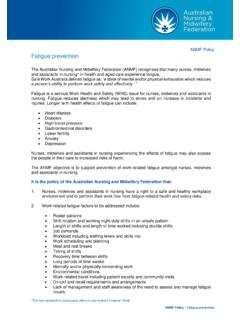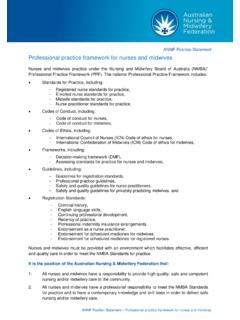Transcription of Nurses and information technology - anf.org.au
1 Nurses and information technology Nurses and information technology An Australian Nursing Federation project funded by the Australian Government Department of Health and Ageing Acknowledgement: The authors would like to thank all the Nurses in Australia who responded to the survey; the members of the stakeholder and focus groups; and Erin Bowly, Annette Nanka and Rebecca Shaw for administrative support. The authors would also like to thank the members of the project steering group for their contribution to the study: Wendy Armstrong Association for Australian Rural Nurses Fiona Stoker Australian Healthcare Association Victoria Gilmore Australian Nursing Federation Margaret Baltais Australian Private Hospitals Association Debra Thoms Chief Nursing Officers Group Jennifer Hardy Council of Deans of Nursing and Midwifery (Australia and New Zealand). Sue Kildea Council of Remote Area Nurses of Australia Yvonne Aggett Department of Health and Ageing Susan Emerson Geriaction Moya Conrick Nursing Informatics Australia Barbara Carter Royal College of Nursing Australia Commonwealth of Australia 2007.
2 ISBN 978-0-909599-55-3. This work is copyright. Apart from any use as permitted under the Copyright Act 1968, no part may be reproduced by any process without written permission from the Commonwealth. Requests and inquiries concerning reproduction and rights should be addressed to the Commonwealth Copyright Administration, Intellectual Property Branch, Department of Communications, information technology and the Arts, GPO Box 2154, Canberra ACT 2601. or posted at The opinions expressed in this report are those of the authors and are not necessarily those of the Australian Government. This project was conducted by the Australian Nursing Federation with funding from the Australian Government Department of Health and Ageing. The research was conducted by a Project Team from the University of Southern Queensland. Nurses and information technology Final Report 1. Professor Desley Hegney 1. Dr Elizabeth Buikstra 1.
3 Dr Robert Eley 1. Dr Tony Fallon 2. Ms Victoria Gilmore 3. Dr Jeffrey Soar June 2007. This project was conducted by the Australian Nursing Federation with funding from the Australian Government Department of Health and Ageing 1 Centre for Rural and Remote Area Health, University of Southern Queensland 2 Australian Nursing Federation 3 Collaboration for Ageing and Aged Care Informatics Research, University of Southern Queensland Table of contents 1. Executive Summary 5. Background 5. Methodology 5. Results 6. Objective 1 6. Objective 2 7. Objective 3 8. Objective 4 9. Objective 5 and recommendations 11. Objective 6 and recommendations 12. Conclusion 13. 2. Literature Review 15. National strategies to support health care through information technology 15. Electronic health records 16. Potential benefits of the adoption of information technology 16. Adoption and use of information technology in health and aged care 17.
4 Knowledge based systems 17. Evidence based practice 18. Telehealth 19. Wireless and hand held technologies 19. Use of the internet 20. Internet access in rural and remote areas 20. Barriers to the adoption of information technology 20. nurse information technology competencies 23. Training 25. 3. The Nurses and information technology study 26. Study aim 26. Study objectives 26. Defining information technology 26. Ethics 26. Project steering group 26. 4. Methodology 27. Data collection methods 27. Stakeholder interviews 27. focus groups 27. The survey tool 28. Piloting the survey tool 28. The survey instrument 28. Sampling 28. Distribution 29. Data entry 30. Data analysis 30. Quantitative data 30. Qualitative data 31. 5. Results 32. Survey responses and stratification 32. Demographics 33. Sex 33. Age 34. Employment 36. Access and use of information technology 40. Level of experience and confidence in using hardware and software 40.
5 Access to computers 42. Use of information technology applications 44. Access to and use of intranet and internet 46. Knowledge of current health information technology initiatives 48. information technology developments within the workplace 48. Adoption of a national electronic health record 48. Knowledge of HealthConnect 49. Knowledge of state and territory health initiatives 49. Employment requirement for information technology skills 49. Employment requirement for information technology skills 49. Importance of access to and use of information technology in 50. choice of employment Importance of information technology in remaining in current employment 50. Importance of access to and use of information technology in choice of 50. future employment Training and education in information technology 50. Formal information technology qualifications 53. Barriers to accessing training 53. Barriers to the use of information technology 54.
6 Technical support 55. Level of technical support 56. Management attitudes and support 57. Security, confidentiality and privacy issues 58. Free comments about information technology in the workplace 58. 6. Discussion 59. Survey responses 59. Experience and confidence in use of information technology 59. Access to computers 62. Use of information technology 63. Access to the intranet and internet 65. Knowledge of health information technology initiatives 66. Employment requirements for information technology 68. Education and training in information technology 69. Barriers to the use of information technology 71. Technical support 72. Management attitudes and support 73. Security, confidentiality and privacy issues 74. Thematic analysis 75. Stakeholder and focus groups 75. 7. Conclusion 76. Recommendations 76. 8. References 78. 9. Appendices 82. List of Tables 1. Definition of position titles used in the study 14.
7 2. Number and percentage of Nurses within jurisdictions surveyed 29. 3. Number of Nurses surveyed and their response rates 32. 4. Responses within states and territories 32. 5. Australian Standard Geographical Classification of respondents 33. 6. Distribution by Australian Standard Geographical Classification of respondents by state 33. and territory 7. Sex of the respondents 34. 8. Sex and Australian Standard Geographical Classification 34. 9. Level of position and sex 34. 10. Age of respondents 35. 11. Sex and age of Nurses 35. 12. Comparison of age of respondents with data from the Australian Institute of Health 35. and Welfare 13. Level of position 36. 14. Level of position and length of time in nursing 36. 15. Aboriginal or Torres Strait Islander origin 37. 16. English as first language 37. 17. English as first language and level of position 37. 18. Main workplace 38. 19. Main role in nursing 39.
8 20. Frequencies of year started work 39. 21. Pre-registration (pre-enrolment) student status 39. 22. Student status and age group 39. 23. Experience and confidence in using hardware and software 40. 24. Proportion of respondents who agreed with statements 41. 25. Place of access for use of a computer for work related activities 42. 26. Use of home computer 43. 27. Reason for home computer use for work related activities 43. 28. Purpose of use of computer for work related purposes 44. 29. Use of different applications for work related purposes 45. 30. Location for accessing email, intranet and internet 46. 31. Location at work of access to the intranet and internet 47. 32. Purpose for accessing the intranet and internet 47. 33. Degree of restriction to using the intranet and internet 48. 34. Awareness of information technology development at the workplace 48. 35. Benefit of national electronic health records 48.
9 36. Knowledge of HealthConnect 49. 37. Requirement for information technology in position and level of position 49. 38. Training pre-registration or pre-enrolment and as continuing professional education 51. 39. Employer support of information technology training by level of position 52. 40. Barriers to accessing training 53. 41. Interest in national competency in information technology 54. 42. Barriers to use of computers 54. 43. Technical support policy exists within organisation 55. 44. Provider of information technology support 56. 45. Level of weekday technical support 56. 46. Level of technical support on weekends 57. 47. Rating of management attitude and support 57. 48. Support by management for health and safety issues 57. 49. Rating of security 58. 50. Themes from qualitative analysis 58. Glossary of Terms ACT Australian Capital Territory AIN Assistant in Nursing ASGC Australian Standard Geographical Classification CPE Continuing Professional Education EN Enrolled nurse (registered nurse division 2 in Victoria).
10 IMS information Management System IR Inner Regional IT information technology MCC Major Capital City NSW New South Wales NT Northern Territory QLD Queensland OR Outer Regional PC Personal Carer RN Registered nurse (registered nurse division 1 in Victoria). RVR Remote/Very Remote SA South Australia TAS Tasmania VIC Victoria WA Western Australia 1 Executive Summary Synopsis: A study of 10,000 Nurses in Australia (44% response rate) on their use of information technology has clearly identified that Nurses recognise benefits to adopting more information technology in the workplace. They are however frustrated by limitations of access to the technology ;. software that is not always fit for purpose; and lack of opportunities for training. The level of use of information technology and information management systems is generally low and confidence in use is low even among those Nurses who are users. There is evidence that familiarity, use and confidence in use are slightly higher in Nurses who have recent tertiary education.











